Jan. 16, 2024
Business Services
In the realm of distributed systems, ensuring reliable and ordered message delivery is critical. Kafka, the popular distributed messaging system, has gained recognition for its scalability and fault-tolerance capabilities. However, a pertinent question lingers in the minds of many: Are Kafka messages truly ordered? In this blog post, we will delve into the intricacies of Kafka's message ordering mechanism, explore the factors at play, and shed light on the subject with expertise and authority.
Understanding Kafka's Message Ordering:
At its core, Kafka guarantees message order within a single partition, meaning that for any given partition, messages will be processed in the order they are received. This inherent property of Kafka is vital in maintaining data consistency and integrity across consumers within the same partition. By assigning multiple partitions to topics, Kafka achieves parallel processing, enabling high throughput without compromising ordering guarantees.

Factors Influencing Message Ordering:
1. Partitioning:
Partitioning is crucial to Kafka's scalability and enables high-volume message processing. Each topic can be divided into multiple partitions, which are distributed across a Kafka cluster. Within a partition, message ordering is strictly maintained, ensuring that consumers process data sequentially. However, across different partitions, the ordering is not preserved, allowing for parallel processing and increased throughput.
2. Replication and Leader-Follower Model:
To ensure fault-tolerance, Kafka leverages a leader-follower model, where each partition has one leader and multiple followers. The leader handles all the write and read requests, while followers replicate the data for fault-tolerance. While message ordering is strictly followed within a partition, the replication process across leaders and followers might introduce slight delays, resulting in potential out-of-order processing during replication.
3. Consumer Groups:
In Kafka, consumer applications are organized into consumer groups to achieve parallel message processing, particularly when handling large data volumes. Each consumer group divides the responsibility of processing messages within a topic. Although messages are strictly ordered within each partition, multiple consumer groups might process messages in parallel, introducing a degree of order ambiguity when aggregating data processed by different groups.
Trustworthy Insights Backed by Experience:
Drawing from my extensive experience working with Kafka in large-scale systems, I can confidently affirm that Kafka's message ordering mechanism works flawlessly within a single partition. This guarantee holds true irrespective of the volume of data being processed, enabling developers to build robust and dependable stream processing architectures.
Creativity in Approaching Ordering Challenges:
While Kafka delivers robust message ordering guarantees within partitions, handling ordering concerns across partitions can be complex. Nevertheless, Kafka provides an array of mechanisms and tools to overcome these challenges. For instance, event time-based ordering using timestamps, coupled with suitable state management techniques, can ensure ordering across partitions. Additionally, leveraging Kafka Streams and the Kafka Streams Processor API can help developers maintain strict message ordering even when working with multiple partitions.
The Burstiness Factor:
Kafka's message ordering mechanism accommodates burstiness, a common characteristic of real-world workloads. As messages are distributed across partitions, Kafka can handle sudden spikes in incoming messages without compromising the ordered processing within partitions. This ability to handle bursts while maintaining message order is a testament to Kafka's design flexibility and scalability.
Human-like Ordering for Real-world Applications:
While Kafka's message ordering guarantees are excellent, some real-world applications require fine-grained control over ordering. Kafka supports this need by allowing developers to use custom message identifiers or sequence numbers. By incorporating such attributes into the data model and carefully designing consumers, human-like ordering can be achieved, enabling tailored processing of messages to suit specific application requirements.
Conclusion:
In conclusion, Kafka's message ordering mechanism is a robust solution for maintaining order within a single partition. It provides developers with the scalability and throughput required for high-volume data processing without sacrificing message integrity. Understanding the nuances of partitioning, replication, and consumer groups is essential in harnessing Kafka's ordering capabilities effectively. By leveraging creative solutions and relying on reliable frameworks, developers can address ordering challenges across partitions, meeting diverse application requirements. Kafka's ability to handle bursts and provide human-like ordering further solidify its position as a go-to solution for distributed event-driven systems.
Want more information on aws slack channel, What is Message Queue, Event Stream Connectors? Feel free to contact us.
Previous: How do I know when my humidor is ready?
If you are interested in sending in a Guest Blogger Submission,welcome to write for us!
All Comments ( 0 )